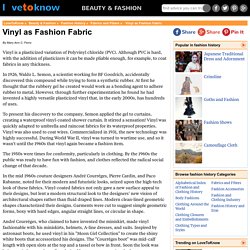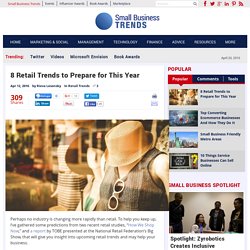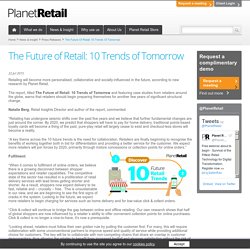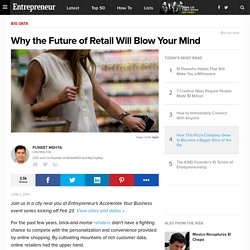

Vinyl as Fashion Fabric. Vinyl is a plasticized variation of Polyvinyl chloride (PVC).

Although PVC is hard, with the addition of plasticizers it can be made pliable enough, for example, to coat fabrics in any thickness. In 1926, Waldo L. Semon, a scientist working for BF Goodrich, accidentally discovered this compound while trying to form a synthetic rubber. At first he thought that the rubbery gel he created would work as a bonding agent to adhere rubber to metal. However, through further experimentation he found he had invented a highly versatile plasticized vinyl that, in the early 2000s, has hundreds of uses. To present his discovery to the company, Semon applied the gel to curtains, creating a waterproof vinyl-coated shower curtain.
The 1950s were times for conformity, particularly in clothing. In the mid 1960s couture designers André Courréges, Pierre Cardin, and Paco Rabanne, noted for their modern and futuristic looks, seized upon the high-tech look of these fabrics. Bibliography. What are the general differences between Nike and Adidas shoe products? - Quora. Brown Resume-1. 8 Upcoming Retail Trends to Prepare For in 2016. Perhaps no industry is changing more rapidly than retail.

To help you keep up, I’ve gathered some predictions from two recent retail studies, “How We Shop Now,” and a report by TOBE presented at the National Retail Federation’s Big Show, that will give you insight into upcoming retail trends and may help your business. Rent, Don’t Buy Taking a cue from the sharing economy and businesses such as Uber and Airbnb, 15 percent of U.S. consumers are interested in renting products from stores. The most popular products people wanted to rent are exercise equipment (17 percent), consumer electronics (15 percent) and furniture (11 percent).
The general idea is a subscription program that lets customers rent a certain amount (or an unlimited amount) of the items in question. Class Is In Session Nearly one-third (32 percent) of consumers are interested in going to classes or lessons at stores. Rich Rewards Sensory Stimulation Seeking Slouch Sweet Memories Feel the Passion Uniform Approach. The Future of Retail: 10 Trends of Tomorrow. Retailing will become more personalised, collaborative and socially-influenced in the future, according to new research by Planet Retail.

The report, titled The Future of Retail: 10 Trends of Tomorrow and featuring case studies from retailers around the globe, warns that retailers should begin preparing themselves for another few years of significant structural change. Natalie Berg, Retail Insights Director and author of the report, commented: “Retailing has undergone seismic shifts over the past five years and we believe that further fundamental changes are just around the corner.
By 2020, we predict that shoppers will have to pay for home delivery, traditional points-based loyalty cards will become a thing of the past, pure-play retail will largely cease to exist and checkout-less stores will become a reality. “A key theme across the 10 future trends is the need for collaboration. Fulfilment “Click & collect will continue to bridge the gap between online and offline retailing. Loyalty 1. Why the Future of Retail Will Blow Your Mind. Join us in a city near you at Entrepreneur’s Accelerate Your Business event series kicking off Feb 23.

View cities and dates » For the past few years, brick-and-mortar retailers didn’t have a fighting chance to compete with the personalization and convenience provided by online shopping. By cultivating mountains of rich customer data, online retailers had the upper hand. Every action and inaction -- from what customers clicked on and how much time they spent looking at certain products to their social activity and response to email programs – helped online retailers tailor each email, pop-up or recommended product to drive sales and provide a superior experience. For consumers, it was a welcome reprieve from the antiquated task of visiting a store, being treated as a stranger and receiving often-questionable customer service. This new customer journey had new engagement touch points across marketing, sales and service, and traditional retailers struggled to keep up. 1. 2. 3. 4. 5. 6. 7.
Retail Store of the Future.